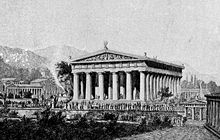User:Jgford1/sandbox
Temple of Zeus at Olympia, Eastern Pediment
[edit]
The Eastern Pediment of the Temple of Zeus at Olympia depicts the tale of Pelops just before the chariot race[1] wherein he kills the king Oenomaus in order to win the hand of his daughter Hippodamia.[2] The depiction of this chariot race on the east pediment of the Temple of Zeus, along with that of the 12 labors of Heracles on the metopes of the frieze, relate to the location of the temple in Olympia; the chariot race and Heracles were both believed to have started the tradition of the Olympic Games.[3]
Description
[edit]
In the center stands Zeus watching over Pelops to his right and Oenomaus to his left. Beside them are two female figures, followed by the chariots about to be raced on. In the corners of the pediment are male figures, presumably spectators, who are sitting or lying down in order to fill the narrow space.[4]
Location
[edit]Olympia is in the northwest portion of the Peloponnese. It was a panhellenic sanctuary, meaning that it was open to all greeks regardless of the city-state they're a part of. Olympia was also home of the Olympic Games, a Panhellenic athletic tournament occurring every four years wherein a a sacred truce was declared among the poleis.[3]
Mythology
[edit]
In Greek mythology, Pelops had sought to marry Hippodamia. Her father, King Oenomaus, did not want to marry off his daughter, so he challenged each of her suitors to a chariot race. Before Pelops, he had beaten and killed all of these suitors, for he had immortal horses given to him by his father Ares. Pelops, however, called on Poseidon, his former lover, for assistance, and he gave Pelops a gold chariot with winged horses puling it. Another common view is that Pelops had bribed Oenomaus's charioteer, Myrtilus, into replacing the bronze linchpins of the chariot with ones made of wax. Afterwards, Pelops kills Myrtilus in order to avoid paying the bribe.[5]
 | This is a user sandbox of Jgford1. You can use it for testing or practicing edits. This is not the sandbox where you should draft your assigned article for a dashboard.wikiedu.org course. To find the right sandbox for your assignment, visit your Dashboard course page and follow the Sandbox Draft link for your assigned article in the My Articles section. |
- ^ T.,, Neer, Richard. Greek art and archaeology : a new history, c. 2500-c. 150 BCE. New York. ISBN 9780500288771. OCLC 745332893.
{{cite book}}: CS1 maint: extra punctuation (link) CS1 maint: multiple names: authors list (link) - ^ "Pelops | Greek mythology". Encyclopedia Britannica. Retrieved 2017-11-01.
- ^ a b "Olympia | The Encyclopedia of Ancient History - Credo Reference". search.credoreference.com. Retrieved 2017-12-03.
- ^ Artstor. "Artstor". library.artstor.org. Retrieved 2017-11-01.
- ^ "Pelops | Dictionary of Classical Mythology - Credo Reference". search.credoreference.com. Retrieved 2017-12-03.
